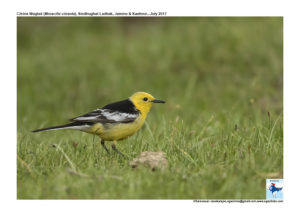Citrine Wagtail

Citrine Wagtail Motacilla citreola
Etymology :
- Motacilla : Greek word muttex type of bird mentioned by Hesychius. It is a diminutive of motare, ” to move about”, from medieval times it led to the misunderstanding of cilla as “tail”.
- Citreola : Latin word for “lemon-coloured” derived from citreus –citrine
Vernacular Names : Hindi: Pilkya, Pani-ka-pilkya, Sans: Jal khajjan, Pitta-shirsha khajjan, Kash: Ledor dobbai, Peench kani, Pun: Pila si mamola, Mirshikars: Pan pillakh, M.P.: On munda, Ass: Tooni, Guj: Pila mathano pilakiyo, Mar: Pivalya dokyacha dhobi
Distribution in India:Breeds in Himalayas and wide spread winter visitorexcept in Peninsular area in India.
Description: Size of 16·5–20 cm; wt. of 18–25 g. The male of nominate race in breeding plumage has bright yellow head and underparts, black lower hindneck and upper mantle, black extending slightly onto breast side. The lower mantle and scapulars are dark grey, tinged olive, rump is dark slate-grey, uppertail-coverts are black; remiges and greater and median wing-coverts are dark brown to black with pale edgings, white covert tips form two wingbars, lesser coverts are dark olive-grey. The tail is mostly black, outer two feather pairs are mainly white with black bases. The yellow of underparts are washed olive-grey on side of breast and flanks. It has blackish spots on breast side, undertail-coverts are yellowish-white; iris is dark brown; bill is black; legs are black or blackish-brown. Non-breeding male is duller, hindcrown to mantle and scapulars are dark olive-grey to grey, sometimes some dark mottling above, yellow areas are paler. The female resembles non-breeding male; non-breeding female is duller, greyer above, yellow areas are paler, grey on side of breast and flanks, and whiter on belly. The immature has little or no yellow in plumage, is more buff and more grey than non-breeding female, olive-brown on breast side and flanks. The races differ mainly in colour tones of breeding male, but much individual variation. The racewerae male differs from nominate in having purer grey back with no dusky suffusion, paler below with less grey on flanks, female is similar to nominate, on average slightly smaller. The race calcarata male differs in having all-black upperparts, deeper yellow of head and underparts extending to undertail-coverts, edges of tertials are broader and purer white, greater coverts are often all white, often more black on inner webs of outer two rectrices, the female is similar to nominate but may show diffuse blackish spots on mantle to rump, more blackish uppertail-coverts, has more yellowish-tinged undertail-coverts, on average longer bill and tarsus. It is found in marshes, edges of lakes, willow thickets and wet rough grassland in tundra, also areas of willow bushes on mountain meadows and sometimes in fields near villages. In non-breeding season similarly wet habitats, including also coastal marshes, brackish lagoons, sewage farms and irrigated land, wet paddy fields, lake margins and riverine sandbars. It is found from sea-level up to 4600 m.
Food habits : It eats small terrestrial and aquatic invertebrates, ranging from weevils and other beetles, dragonflies,adult and larval flies, termites and ants,spiders, small snails, crustaceans and worms, fish fry; crumbs and other household scraps also taken. It forages by picking and darting for prey; takes items from the ground, from low vegetation or from water surface. It walks on open wet ground at edge of water and on floating mats of aquatic vegetation such as water hyacinth. It wades in shallow water. It flutters up to snatch an insect in air.
Breeding habits: They breed in Apr–Jun and May–Aug (calcarata).They lay two broods. They are monogamous and territorial. The nest is built by female. The nest is a cup of moss and plant leaves and stems, lining of hair, wool and feathers, placed on ground in grassy vegetation. They lay a clutch of 3–6 eggs. The incubation is done by both sexes. The incubation period is 14–15 days. The nestling period is 10–13 days.